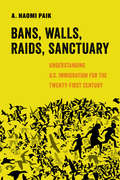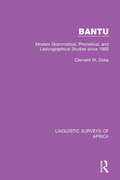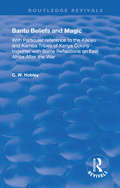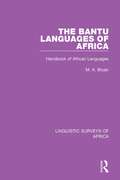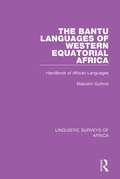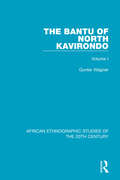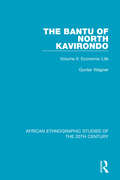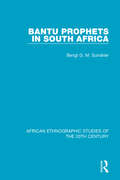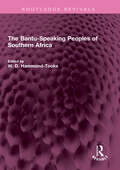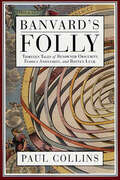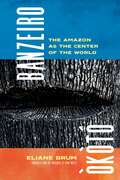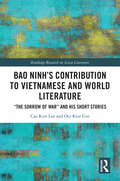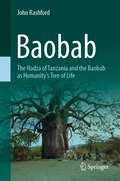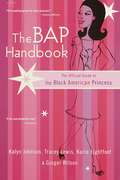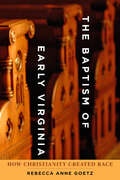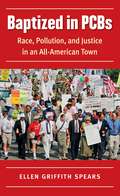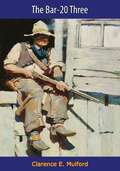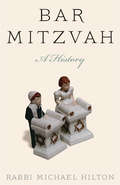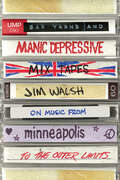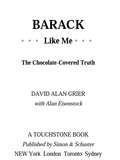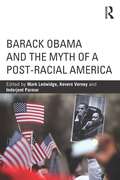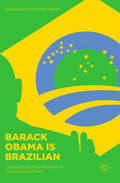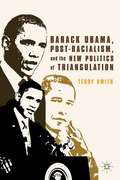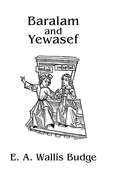- Table View
- List View
Bans, Walls, Raids, Sanctuary: Understanding U.S. Immigration for the Twenty-First Century (American Studies Now: Critical Histories of the Present #12)
by A. Naomi PaikDays after taking the White House, Donald Trump signed three executive orders—these authorized the Muslim Ban, the border wall, and ICE raids. These orders would define his administration’s approach toward noncitizens. An essential primer on how we got here, Bans, Walls, Raids, Sanctuary shows that such barriers to immigration are embedded in the very foundation of the United States. A. Naomi Paik reveals that the forty-fifth president’s xenophobic, racist, ableist, patriarchal ascendancy is no aberration, but the consequence of two centuries of U.S. political, economic, and social culture. She deftly demonstrates that attacks against migrants are tightly bound to assaults against women, people of color, workers, ill and disabled people, and queer and gender nonconforming people. Against this history of barriers and assaults, Bans, Walls, Raids, Sanctuary mounts a rallying cry for a broad-based, abolitionist sanctuary movement for all.
Bantu: Modern Grammatical, Phonetical and Lexicographical Studies Since 1860 (Linguistic Surveys of Africa #10)
by Clement M. DokeOriginally published in 1945, this volume represented the first to classify Bantu languages. This volume does not record all the dialects but makes reference to those in which some grammatical study has been done and classifies them according to mainly geographical zones. Owing to tribal migrations, individual members of a particular zone may be living among members of a different zone (as has been the case with the Ngoni, South-Eastern Zone, who are found among the Eastern Bantu), but the zone label is taken from the habitat of the majority.
Bantu Beliefs and Magic: with particular reference to the Kikuyu and Kamba tribes of Kenya colony; together with some reflections on east Africa after the war (Routledge Revivals)
by C. W. HobleyFirst published in 1922, the author of this book was for many years a Provincial Commissioner of what was then the Kenya Colony whose main objects were to place on record the results of investigations made among the native tribes in British East Africa, particularly among the Kikuyu and Kamba people, and to endeavour from a study of their ceremonial with regard to sacrifice and taboo, to obtain a better insight into the principles which underlie the outward forms and ceremonies of their ritual. Together with natural religion and magic, the author discusses a variety of social activities influenced by religious beliefs, such as the organisation of councils, ceremonial oaths, war and peace, dances, legends, and the position of women in tribal society. The functions of some of the practices are self-evident or can be explained within the limits of psychological or anthropological terms, whilst others remain unexplained and seem inexplicable, even futile. The author’s careful analysis of this last class provides interesting ethnological comment, for in seeking a better understanding of the psychology of one particular race, he draws attention also to analogous conditions of religious customs existing amongst other widely differing races. In the last chapter, ‘Quo Vadis’, added to the second edition of 1938, the author furthers his discussion of East Africa after the war. Together with the factual analysis of the first three parts, these additional observations, invaluable once to administrators and all concerned in colonial government, today prove their value not only for students of East Africa, but for all those endeavouring to arrive at an adjustment between the old native social structure and the extraneous forces now operating with ever increasing intensity.
The Bantu Languages of Africa: Handbook of African Languages (Linguistic Surveys of Africa #17)
by M. A. BryanThe area covered by this book, originally published in 1953, is one that has long been recognized as presenting many problems from the point of view of Bantu linguistic studies. Almost all the material set out in this present work is based on notes taken in the field, and in many cases presented completely new facts. The sources of the information used are listed at the end of the linguistic description of each of the groups of languages dealt with. Since there are so many languages to be covered it would be impracticable to give even an outline of the main features of each of them, so an outline is given of the main characteristics of each separate group. One language is used as the type for each group, for the purpose of listing examples of the nominal prefixes, verbal conjugation, and personal prefixes. Other features are illustrated from whichever language is the most suitable.
The Bantu Languages of Western Equatorial Africa: Handbook of African Languages (Linguistic Surveys of Africa #16)
by Malcolm GuthrieThe area covered by this book, originally published in 1953, is one that has long been recognized as presenting many problems from the point of view of Bantu linguistic studies. Almost all the material set out in this present work is based on notes taken in the field, and in many cases presented completely new facts. The sources of the information used are listed at the end of the linguistic description of each of the groups of languages dealt with. Since there are so many languages to be covered it would be impracticable to give even an outline of the main features of each of them, so an outline is given of the main characteristics of each separate group. One language is used as the type for each group, for the purpose of listing examples of the nominal prefixes, verbal conjugation, and personal prefixes. Other features are illustrated from whichever language is the most suitable.
The Bantu of North Kavirondo: Volume 1
by Gunter WagnerOriginally published in 1949, this is the first of 2 volumes studying the Bantu tribes inhabiting the westernmost part of Kenya. The book analyses family, lineage and clan structure, kinship relations and the various rituals connected with every stage of the human life cycle. Also included is a section on European colonization and its effects and the magico-religious and ceremonial aspects of tribal life.
The Bantu of North Kavirondo: Volume 2: Economic Life
by Gunter WagnerOriginally published in 1956, this second volume of the Bantu of North Kenya (Kavirondo) discusses the traditional Bantu economy, as well as 20th century developments as a result of Western contact. The topics dealt with include technology, food production, land tenure and use, rights in cattle, exchange and trade.
Bantu Prophets in South Africa
by Bengt G. SundklerOriginally published in 1948 and then updated in 1961 outlines the religious and social background of the Zulus and discusses the rise of the Independent Church Movement. It examines the organization and inner workings of the different Churches, their forms of worship, and the personalities of their leaders. It also analyses the blend of old and new which appears in Zulu interpretations of some aspects of Christian doctrine.
The Bantu-Speaking Peoples of Southern Africa (Routledge Revivals)
by W. D. Hammond-TookeFirst published in 1974, The Bantu-Speaking Peoples of Southern Africa is a revised and rewritten version of I. Schapera’s ethnographical survey of the Bantu-speaking tribes of South Africa. New South African contributors place on record all the known facts of the physical characteristics and traditional cultures of these peoples, as well as documenting the important social, cultural and economic changes that have occurred since the coming of the white man. This book will be of interest to students of anthropology, sociology, African studies, and history.
Banvard's Folly: Thirteen Tales of Renowned Obscurity, Famous Anonymity, and Rotten Luck
by Paul Collins“Hearteningly strange . . . Collins exhumes little-known figures [and] recounts their perversely inspiring battles against the more logical ways of the world.” —The OnionHere are thirteen unforgettable portraits of forgotten people: men and women who might have claimed their share of renown but who, whether from ill timing, skullduggery, monomania, the tinge of madness, or plain bad luck—or perhaps some combination of them all—leapt straight from life into thankless obscurity.Collins brings them back to glorious life. John Banvard was an artist whose colossal panoramic canvasses (one behemoth depiction of the entire eastern shore of the Mississippi River was simply known as “The Three Mile Painting”) made him the richest and most famous artist of his day . . . before he decided to go head to head with P. T. Barnum. René Blondot was a distinguished French physicist whose celebrated discovery of a new form of radiation, called the N-Ray, went terribly awry. At the tender age of seventeen, William Henry Ireland signed “William Shakespeare” to a book and launched a short but meteoric career as a forger of undiscovered works by the Bard—until he pushed his luck too far.Collins’ love for what he calls the “forgotten ephemera of genius” give his portraits of these figures and the other ten men and women in Banvard’s Folly sympathetic depth and poignant relevance. Their effect is not to make us sneer or revel in schadenfreude; here are no cautionary tales. Rather, here are brief introductions—acts of excavation and reclamation—to people whom history may have forgotten, but whom now we cannot.
Banzeiro Òkòtó: The Amazon as the Center of the World
by Eliane BrumA confrontation with the destruction of the Amazon by a writer who moved her life into the heart of the forest.In lyrical, impassioned prose, Eliane Brum recounts her move from São Paulo to Altamira, a city along the Xingu River that has been devastated by the construction of one of the largest dams in the world. In community with the human and more-than-human world of the Amazon, Brum seeks to “reforest” herself while building relationships with forest peoples who carry both the scars and the resistance of the forest in their bodies. Weaving together the lived stories of the region and its history of violent corruption and destruction, Banzeiro Òkòtó is a call for radical change, for the creation of a new kind of human being capable of facing the potential extinction of our species. In it, Brum reveals the direct links between structural inequities rooted in gender, race, class, and even species, and the suffering that capitalism and climate breakdown wreak on those who are least responsible for them.The title Banzeiro Òkòtó features words from two cultural and linguistic traditions: banzeiro is what the Amazon people call the place where the river turns into a fearsome vortex, and òkòtó is the Yoruba word for a shell that spirals outward into infinity. Like the Xingu River, turning as it flows, this book is a fierce document of transformation arguing for the centrality of the Amazon to all our lives.
Bao Ninh's Contribution to Vietnamese and World Literature: "The Sorrow of War" and his Short Stories (Routledge Research on Asian Literature)
by Cao Kim Lan Ooi GinBao Ninh's Contribution to Vietnamese and World Literature analyzes and presents the works of Bao Ninh, the most well-known writer in modern Vietnamese literature. His works are renowned both in Vietnam and worldwide and his novel The Sorrow of War, which has been translated into more than 15 languages, is considered to be one of the classic works of war literature.This book by two award-winning scholars, one in war literature and the other in war history, presents for the first time an overall assessment of Bao Ninh’s works, notably of his celebrated novel and his short stories. It outlines his life, setting it in the context of war-torn Vietnam whence he was a teenage soldier at the age of 17 in the North Vietnamese People's Army (NVPA); highlights the main themes of the corpus of his writings, inter alia of suffering and trauma of war impacts of post-traumatic stress disorder (PTSD) of veterans, of the futility of war; discusses his approach to writing; compares his writings with others in war literature; and examines and assesses his especial place in world literature. This pioneering monograph of the scholarly evaluation of Bao Ninh himself and his works further engages in the discourse of his contribution to modern Vietnamese literature and world literature. Encouraging a better understanding of wars and conflicts, the book will be of interest to researchers and students in the fields of modern Asian history, in particular the Vietnam War, Southeast Asian Studies, and Vietnamese and World literature.
Baobab: The Hadza of Tanzania and the Baobab as Humanity's Tree of Life
by John RashfordModern humans, descendants of a founding population that separated from chimpanzees some five to eight million years ago, are today the only living representative of a branching group of African apes called hominins. Because of its extraordinary size and shape, the baobab (Adansonia digitata L.) has long been identified as the most striking tree of Africa’s mosaic savanna, the landscape generally regarded as the environment of hominin evolution. This book makes the case for identifying the baobab as the tree of life in the hunter-gatherer adaptation that was the economic foundation of hominin evolution. The argument is based on the significance of the baobab as a resource-rich environment for the Hadza of northeastern Tanzania, who continue to be successful hunter-gatherers of the African savanna.
The BAP Handbook: The Official Guide to the Black American Princess
by Ginger Wilson Kalyn Johnson Tracey Lewis Karla Lightfoot"Finally, a book about the Black American Princess! If you're already a BAP or just want to act like one, this book is for you!" — E. Lynn Harris, author of Not a Day Goes ByIn the bestselling tradition of The Official Preppy Handbook, here is a must-have manual for the BAP and those who love her.Black American Princess: 1 : a pampered female of African American descent, born to an upper-middle or upper-class family 2 : an African American female whose life experiences give her a sense of royalty and entitlement 3 : BAP (acronym) : colloquial expression 4 : an African American female accustomed to the best and nothing less. Drawn from hours of interviews, archival research, and frequent visits to Prada, The Black American Princess Handbook offers a rare behind-the-scenes look at this exclusive lifestyle. Your total guide to BAP speak, BAP style, and BAP history, this one-of-a-kind book explains everything you ever wanted know about living the BAP life–from breaking in a shop-a-phobic dad to planning a magical BAP debutante ball.In addition, you'll learn why a true BAP cleans her house before the housekeeper arrives, what to do if your Baby BAP wants to play sports, and whether it's OK for a relative to sing "I Believe I Can Fly" at a BAP wedding. Also featuring spot-the-BAP checklists, suggestions for top BAP colleges, a Who's Who of famous BAPs, a glossary (including essential French phrases), actual diary entries and e-mails from BAPS of all ages, and crucial chapters such as "It's High Noon-Do You Know Where Your Groove Is?"The Black American Princess Handbook is destined to become a coveted treasure for BAPs worldwide. And, published just in time for graduation, it's sure to be at the top of every BAP's shopping list.
The Baptism of Early Virginia: How Christianity Created Race (Early America: History, Context, Culture)
by Rebecca Anne GoetzChristianity's role in furthering racism in early America.In The Baptism of Early Virginia, Rebecca Anne Goetz examines the construction of race through the religious beliefs and practices of English Virginians. She finds the seventeenth century a critical time in the development and articulation of racial ideologies—ultimately in the idea of "hereditary heathenism," the notion that Africans and Indians were incapable of genuine Christian conversion. In Virginia in particular, English settlers initially believed that native people would quickly become Christian and would form a vibrant partnership with English people. After vicious Anglo-Indian violence dashed those hopes, English Virginians used Christian rituals like marriage and baptism to exclude first Indians and then Africans from the privileges enjoyed by English Christians—including freedom.Resistance to hereditary heathenism was not uncommon, however. Enslaved people and many Anglican ministers fought against planters’ racial ideologies, setting the stage for Christian abolitionism in the late eighteenth and early nineteenth centuries. Using court records, letters, and pamphlets, Goetz suggests new ways of approaching and understanding the deeply entwined relationship between Christianity and race in early America.
Baptized in PCBs
by Ellen Griffith SpearsIn the mid-1990s, residents of Anniston, Alabama, began a legal fight against the agrochemical company Monsanto over the dumping of PCBs in the city's historically African American and white working-class west side. Simultaneously, Anniston environmentalists sought to safely eliminate chemical weaponry that had been secretly stockpiled near the city during the Cold War. In this probing work, Ellen Griffith Spears offers a compelling narrative of Anniston's battles for environmental justice, exposing how systemic racial and class inequalities reinforced during the Jim Crow era played out in these intense contemporary social movements. Spears focuses attention on key figures who shaped Anniston--from Monsanto's founders, to white and African American activists, to the ordinary Anniston residents whose lives and health were deeply affected by the town's military-industrial history and the legacy of racism. Situating the personal struggles and triumphs of Anniston residents within a larger national story of regulatory regimes and legal strategies that have affected toxic towns across America, Spears unflinchingly explores the causes and implications of environmental inequalities, showing how civil rights movement activism undergirded Anniston's campaigns for redemption and justice.
The Bar-20 Three
by Clarence E. MulfordA HARD-RIDING, QUICK-SHOOTING ADVENTURE, FEATURING HOPALONG CASSIDYHopalong Cassidy, Red Connors and Johnny nelson rode across the searing inferno of the Staked Plains and challenged Kane—who dominated the country like a colossus.They rode with vengeance in their hearts and with an implacable resolve to wipe Kane and his cohorts out.“Kane,” Johnny said, “you’ve been too big for too long. We’re cutting you down to size—with guns.”Johnny Nelson, Hopalong Cassidy’s young protégé, has finally got hitched, bought into a ranch, and run into rustlers, bank robbers, and thieves with murder on their mind. It is possible Johnny, Hoppy, and Red Conners, three men from the Bar-20, can bring an end to this reign of terror?
Bar Mitzvah, a History: A History
by Rabbi Michael HiltonThe Jewish coming-of-age ceremony of bar mitzvah was first recorded in thirteenth-century France, where it took the form of a simple statement by the father that he was no longer responsible for his thirteen-year-old son. Today, bar mitzvah for boys and bat mitzvah for girls are more popular than at any time in history and are sometimes accompanied by lavish celebrations.How did bar mitzvah develop over the centuries from an obscure legal ritual into a core component of Judaism? How did it capture the imagination of even non-Jewish youth? Bar Mitzvah, a History is a comprehensive account of the ceremonies and celebrations for both boys and girls. A cultural anthropology informed by rabbinic knowledge, it explores the origins and development of the most important coming-of-age milestone in Judaism. Rabbi Michael Hilton has sought out every reference to bar mitzvah in the Bible, the Talmud, and numerous other Jewish texts spanning several centuries, extracting a fascinating miscellany of information, stories, and commentary.
Bar Yarns and Manic-Depressive Mixtapes: Jim Walsh on Music from Minneapolis to the Outer Limits
by Jim WalshBar Yarns and Manic Depressive Mix Tapes distills thirty delirious, jam-packed years of some of the best music writing ever to come out of the Twin Cities. As a writer and musician, the ever-curious Jim Walsh has lived a life immersed in music, and it all makes its way into his columns and feature articles, interviews and reviews, including personal essays on life, love, music, family, death, and, yes, the manic-depressive highs and lows that come with being an obsessive music lover and listener. From Minneapolis&’s own Prince to such far-flung acts as David Bowie, the Waterboys, Lucinda Williams, Parliament-Funkadelic, L7, the Rolling Stones, the Ramones, U2, Hank Williams, Britney Spears, Elvis Presley and Nirvana, Walsh&’s work treats us to a chorus of the voices and sounds that have made the music scene over the past three decades. The big names are here, from Rosanne Cash to Bruce Springsteen to Bob Marley and Jackson Browne, but so are those a little shy of superstardom, like the Tin Star Sisters and Uncle Tupelo, Son Volt, the Gear Daddies, Semisonic, and The Belfast Cowboys. The book is also a tour (de force) of the Twin Cities' most celebrated music venues past and present, from the Prom Ballroom to Paisley Park to Duffy's. When Walsh isn't celebrating the sheer magic of live music or dreaming to tunes blasting from the car console, he might be surveying the scene with the Hamm's Bear at Grumpy's or the Double Deuce or singing the last night at the Uptown Bar blues. Whether he's dishing dirt with Yoko Ono or digging the Replacements' roots, giving an old rocker a spin or offering a mic to the latest upstart, Jim Walsh reminds us that in the land of a thousand lakes there are a thousand dances, and the music never dies.Capturing the pure notes and character of the sound of the Twin Cities and beyond, with a keen eye for trends and the telling detail, his book truly is a mix tape of thirty years of unforgettable music.
Barack Like Me
by David Alan Grier Alan EisenstockFROM GROWING UP IN DETROIT, where he marched as a ten-year-old with Dr. Martin Luther King Jr., to attending the inauguration of President Barack Obama, where he narrowly avoided the Purple Tunnel of Doom but still saw nothing, David Alan Grier examines how he -- and America -- have changed for the better and the funnier. Within these pages, Grier imagines being called to serve in President Obama's cabinet as the "secretary of mirth"; takes you to a wild and emotional election night party he hosted that didn't go as planned; explains the true meaning of the "magical Negro"; recalls the formative episodes from his life -- including being rejected by the Black Panthers at their headquarters door and turning down the initial offer to work on In Living Color -- and for the first time ever sneaks you backstage at Dancing with the Stars, where he exposes the inner workings of the show -- the camaraderie between dancers and stars, the excruciatingly painful rehearsals, the outrageous preparations, and each hysterical moment of his four-episode appearance and subsequent public meltdown. Grier unabashedly muses on politics, culture, and race while recounting his own life story in this edgy, timeless, hilarious, and revelatory memoir and look at all things Barack. Barack Like Me is David Alan Grier at his best -- the man, comic, and twenty-first-century thinker -- funny, brilliant, and original.
Barack Obama and the Myth of a Post-Racial America: Barack Obama And The Myth Of A Post-racial America (Routledge Series on Identity Politics)
by Mark Ledwidge Kevern Verney Inderjeet ParmarThe 2008 presidential election was celebrated around the world as a seminal moment in U.S. political and racial history. White liberals and other progressives framed the election through the prism of change, while previously acknowledged demographic changes were hastily heralded as the dawn of a "post-racial" America. However, by 2011, much of the post-election idealism had dissipated in the wake of an on-going economic and financial crisis, escalating wars in Afghanistan and Libya, and the rise of the right-wing Tea Party movement. By placing Obama in the historical context of U.S. race relations, this volume interrogates the idealized and progressive view of American society advanced by much of the mainstream literature on Obama. Barack Obama and the Myth of a Post-Racial America takes a careful look at the historical, cultural and political dimensions of race in the United States, using an interdisciplinary analysis that incorporates approaches from history, political science, and sociology. Each chapter addresses controversial issues such as whether Obama can be considered an African-American president, whether his presidency actually delivered the kind of deep-rooted changes that were initially prophesised, and whether Obama has abandoned his core African-American constituency in favour of projecting a race-neutral approach designed to maintain centrist support. Through cutting edge, critically informed, and cross-disciplinary analyses, this collection directly addresses the dimensions of race in American society through the lens of Obama’s election and presidency.
Barack Obama is Brazilian: (Re)Signifying Race Relations in Contemporary Brazil
by Emanuelle K. F. Oliveira-MonteThis book examines US President Barack Obama's characterizations in the Brazilian media, with a specific focus on political cartoons and internet memes. Brazilians celebrate their country as a racial democracy; thus the US works as its nemesis. The rise of a black president to the office of the most prominent country in the global, political, and economic landscape led some analysts to postulate that the US was living in a post-racial era. President Obama's election also had a tremendous impact on the imaginary of the African Diaspora, and this volume investigates how the election of the first black US president complicates Brazilians' own racial discourses. By focusing on three events--Barack Obama's election in 2008, his visit to Brazil in March 2011, and the aftermath of the US espionage on the Brazilian government in 2013--Emanuelle K. F. Oliveira-Monte analyzes Barack Obama's shifting portrayals that confirm and challenge Brazilian racial conceptions projected upon his figure.
Barack Obama, Post-racialism, And The New Politics Of Triangulation
by Terry SmithExamines black voters' relationship to the political process and to the first black president in a prematurely post-racial America using interviews with members of the Congressional Black Caucus, empirical data, news accounts, academic literature and case law.
Baralam And Yewasef: The Ethiopic Version Of A Christianized Recension Of The Legend Of The Buddha And The Bodhisattva
by BudgeFirst published in 2005. Routledge is an imprint of Taylor & Francis, an informa company.
Barbara Bodichon’s Epistolary Education: Unfolding Feminism
by Meritxell Simon-Martin"This book brings together feminist histories in education with an innovative approach to epistolary narrative analytics. In deploying the notion of the epistolary bildung the author rigorously and eloquently shows how the correspondence of Barbara Bodichon can shed fresh light in a range of personal problems and public issues in women’s lives, which remain relevant today"- Maria Tamboukou, Professor of Feminist Studies, University of East London, UKThis book assesses Barbara Bodichon’s significance in the history of the women’s movement in Britain by elaborating a conceptualisation of letters as sources of feminist development. Bodichon was the leader of the first women’s suffrage committee in England, which collected 1,500 signatures in favour of the female vote – a petition presented in the House of Commons by sympathising MPs to support the amendment of the 1867 Reform Bill. This book explores the significance of letter-exchange in Barbara Bodichon’s feminist becoming as she managed to mobilize partisans and secure signatures by means of chains of friendship letters spreading across the country. For letters functioned as platforms where, concomitantly to her making sense of her experiential input, Bodichon adopted, redefined and challenged circulating discourses – transforming them in the process and hence contributing to the production of feminist knowledge, intersubjectively and collaboratively in dialogue with her addressees. At the crossroads of history of feminism, gender history and history of women’s education, this book explores the significance of letter-exchange in Bodichon’s development into one of the galvanizing figures of the women’s rights movement in Victorian England.
